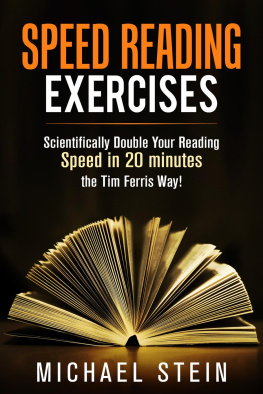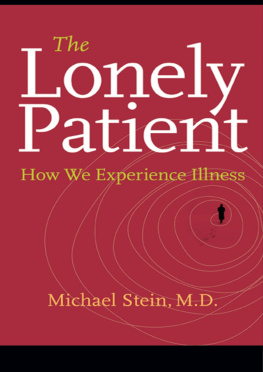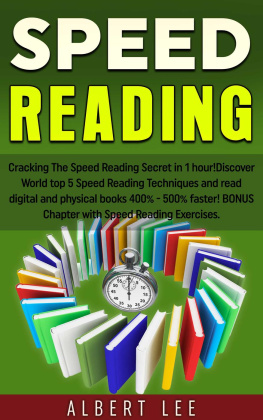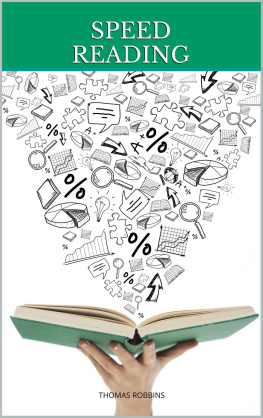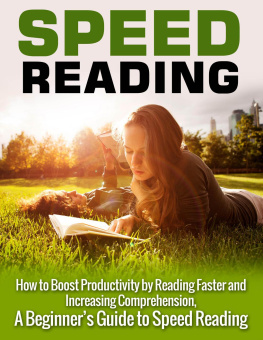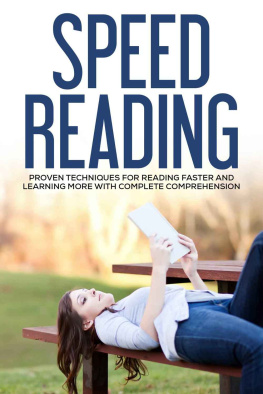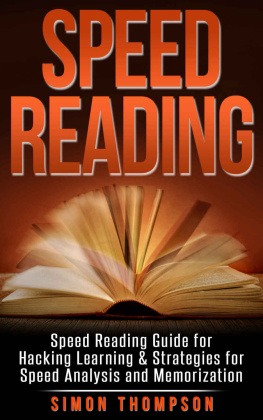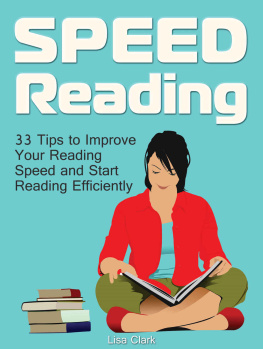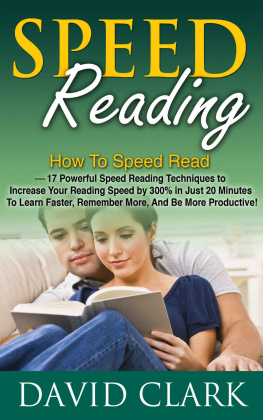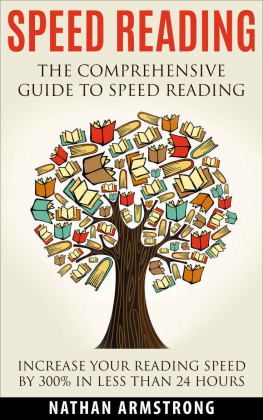Speed Reading Exercises
Scientifically Double Your Reading Speed in 20 Minutes the Tim Ferris Way!
Author: Michael Stein
Table of Contents
Introduction
W hether you were reading an interesting novel, preparing for an exam or reading the newspaper, there is a chance that you have wished to increase your reading speed.
I know that I have.
Did you know that for the average person the reading speed ranges from about 200-300 words per minute. This is fine if you are reading leisurely and have a lot of time on your hand. However, unfortunately, most of us are short on time. We have to turn in our assessments and assignments or learn within a short timeframe. A quicker reading speed could definitely help us get more work done in a short time
or just read more books if you're an avid reader.
With this common problem in mind, many reading exercises were developed. This book extensively covers all the easy yet effective reading exercises you can undertake to double your reading speed in a very short period of time.
All of these exercises are backed by scientific facts. The science behind reading was first understood and then these exercises were established. Many people have practiced and benefited from these exercises and so can you.
Read on to learn to double your reading speed in no time!
Reading vs Talking
A t some point, we all have been guilty of talking aloud while we read. In fact, this habit is encouraged in young children who are just learning to read. However for some of us, this habit sticks even when we have mastered reading.
I mentioned earlier that for the average person, the reading speed is about 200-300 words per minute. It is no coincidence that this is the same as the talking speed for an average adult. It goes on to show that, subconsciously, so many of us are either speaking as we read or reading at the same speed we speak.
Speaking does not necessarily mean that you are talking out aloud for the whole room to hear. In fact, under the breath muttering also counts. Some people just whisper while others move their lips as they read. These all count as talking while you are reading.
You are reading this book right now. Pause and notice.
Were you muttering, whispering or moving your lips?
If yes, then do not fret. Understanding the problem is the first step to remedy it.
The science behind this simple concept is that when you stop talking as you read, your brain no longer thinks that you are engaging in speech. When you engage in speech, you have to make yourself understood hence your brain goes slower. However, the same is not the case for reading. Hence when you separate the two, your reading speed automatically increases.
The simplest way by which you can speed up your reading is by distancing talking from your reading. I know that it is easier said than done as for most of us it is a matter of habit. However, always try to pay attention to what you are doing. Whenever you catch yourself talking alongside, stop yourself right there and try to read without moving your lips even an inch.
You might feel that it is slowing you down initially. You might also feel mildly uncomfortable. However keep in mind that talking while reading is a matter of habit. Any habit kicks up a tantrum when you try to get rid of it. This habit is no different.
Line Jumping
W hen you are reading a written text, your eyes do not remain fixed to a point. Instead, they dart back and forth as you shift from word to word and line to line. Due to this your eyes jump from one point to the other.
As your eyes make the jump, it takes some time to relocate the text and refocus on the reading. You might not even feel or notice the time it takes because it is so small but when added together, it significantly slows down your reading speed.
This jumping of the eye and trying to relocate the position is called "saccades". The time margin for the saccades is greater when you shift the line. This is the reason that you find yourself pausing at the end of the line. The effect is pronounced for a paragraph jump.
You can actually feel the saccadic movements.
Just close your one eye and place the fingertip of your index finger on the closed eyelid. Now read two horizontal lines with the open eye. As you make the line shift, you'll feel a slight twitch in your closed eye. This is the saccadic movement that slows down your reading speed.
So what is the solution to this? How do you minimize the time loss due to the saccadic movements?
The answer is quite simple. Just use a pointer!
I will reference early reading times of kids again. If you have kids, or you remember your own time, you will know that kids are taught to use their index fingers as a pointer while reading. This is to help them remain focused. The concept here is also the same. When you are using a pointer, your eyes are focused on it. So when you shift the line or move across the page, your eyes are fixed on the pointer. They do not notice the jump or the shift because they do not have to refocus. Due to this, saccadic movements can be avoided.
If you have any doubt, repeat the same little experiment with your closed eyelid and index finger but read using a pointer this time. Did your eye twitch this time? Probably not!
Line Fixation
H ow many times have you found yourself reading the same line over and over again?
This often happens when you are reading some boring textbook. You will find yourself in a rut and not realize until a lot of time has elapsed.
This can happen due to a lot of reasons. The major reason is that the text you are reading is boring and is of little or no interest to you. For your brain, there is no incentive to read on any further. There is little chance that you will witness such line fixation when you are reading a gripping thriller or mystery.
This also happens when you are re-reading some text. As is often the case with textbooks. You would have already read all the information in there, but you need to read it again so as to prepare for a test or just to cement the concepts. The reason is the same. Your brain is not interested in reading the same things over and over again.
The simplest solution to this common but annoying problem is to try to develop some interest in what you are reading. This can be quite tricky. However, if you pay attention, you will find something new each time you read. Tell your brain that you are learning something new. You often pre-condition your brain into thinking you already know what you are reading. Due to that, your brain does not pay much attention to it. If you tell yourself that you do not know everything written down, you will be able to read with much more attention and hence avoid such line fixations.
Using a pointer also helps greatly. Since you are moving the pointer, it is a physical manifestation of what you are doing. You will stop in your tracks if you are moving the pointer back and forth, repeating yourself. Your hand muscles will give cue to your brain that something is not right. Due to that, you will recognize the problem and stop the repetition right away.
Another handy trick that you can use is to keep a business card with you at all times. Use it to cover the text that you have already read. This will prevent you from re-reading it over and over again as you will not be able to see it.
With practice, you won't even need any of the tools as you will stop the habit.
Skimming and Scanning
T o be fair, these two are not really speed reading techniques however they can still be quite helpful in most situations.
Most of the times, when you read, you do not need to read word by word. In fact, you only want or need to get an overall understanding of what you are reading. For example, when you are reading a newspaper, you do not need to read every word. You just need to read in such a way that you comprehend the basic message. In fact, newspapers and magazine covers are arranged in such a way that they promote skimming and scanning. This is the reason that there are headlines and bold fonts.
Next page
